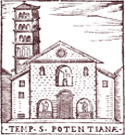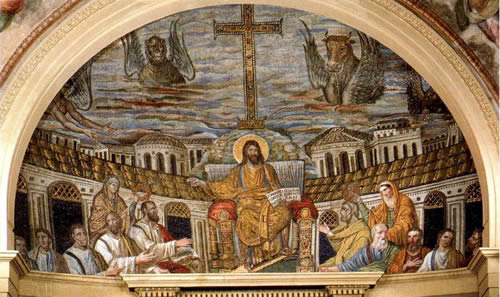The Basilica: The Mosaic of St. Pudenziana
A View of the Mosaic
The Mosaic in the Basilica
The History of the Mosaic
The City of God and the Lordship of Christ
The Mosaic of St.Pudenziana, the Byzantine Mosaics and the Revelation Book
Other Symbols of the Mosaic
The Message of the Mosaic
The Bible: Ephes. 1:15-22
15 …Therefore, I, too, hearing of your faith in the Lord Jesus and of your love 10 for all the holy ones, 16 do not cease giving thanks for you, remembering you in my prayers, 17 that the God of our Lord Jesus Christ, the Father of glory, may give you a spirit of wisdom and revelation resulting in knowledge of him. 18 May the eyes of (your) hearts be enlightened, that you may know what is the hope that belongs to his call, what are the riches of glory in his inheritance among the holy ones, 19 and what is the surpassing greatness of his power for us who believe, in accord with the exercise of his great might, 20 which he worked in Christ, raising him from the dead and seating him at his right hand in the heavens, 21 far above every principality, authority, power, and dominion, and every name that is named not only in this age but also in the one to come. 22 And he put all things beneath his feet and gave him as head over all things to THE CHURCH, 23 WHICH IS HIS BODY, 11 THE FULLNESS OF THE ONE WHO FILLS ALL THINGS IN EVERY WAY.
The Mosaic in the Basilica
- The St. Pudenziana Church is one of the more ancient churches in Rome, if not the most ancient at all. We have documents indeed that the descendants of the Senator Pudens in 154AD gave the Pope Pius I the Pudens house, because he guested in it the Apostles Peter and Paul.
- According to the tradition, Pudens was a Roman Senator converted to the Christian faith by the Apostles Peter and Paul. His greetings are quoted in the Second Letter of St. Paul to Timothy (4:21), confirming his strict relationships with the Apostles.
- The Domus Pudentiana (“the House of Pudens”) became thus a Domus Ecclesia (“a Domestic Church”): the Ecclesia Pudentiana (“the Church of Pudens”). Of this house we have some remains in the excavations at the basement of the actual church.
- The actual structure of the church, however, dates back to the Fourth century. It was originally divided into three naves, like the twin church of St. Praxedes, before the restorations of the XVI cent..
- This restoration transformed the two lateral naves into a series of lateral chapels, built the elliptic couple over the altar, reinforced the Roman columns so to sustain the weight of the new roof vaults, substituting the old, wood trussed roof, so to give the Church the actual Baroque style. Fortunately, the mosaic was saved: the rebuilding of the altar zone cut away only the last two apostles of the Mosaic (they are 10 not 12).
The History of the Mosaic
- In fact, the St. Pudenziana Mosaic is the most ancient apsidal mosaic in the Church. It was made between 410 and 417, during the pontificate of Pope Innocent I, immediately after the shocking event of the so-called “sack (plunder) of Rome” by the Barbarians, leaded by Alaric.
- This event was effectively the “9-11” of the Rome Empire, because it was the first time that many buildings of Rome were destroyed by its enemies, before the definitive end of the Western Roman Empire in 476, sixty years later.
- Differently from many other Churches in Rome - just built after the Constantine Act of 313 that made Christianism the new religion of the Roman Empire -, St. Pudenziana was saved from the distruction by Alaric and his army.
- This event gave the Pope Innocent I the occasion of making the Mosaic for celebrating the Kingship of Christ, as it is tested in the inscription on the book in the hands of Christ in the mosaic: "Dominus Servator Ecclesiae Pudentianae", i.e., "The Lord who saved the Church of Pudens", the Pudenziana Church.
- The date of the Mosaic is thus locatable between 410, the date of the Alaric invasion, and the 417, the date of the death of the Pope Innocent I, as also the most recent studies tested with certainty.
The City of God and the Lordship of Christ
- By this mosaic the Pope wanted to support the faith of Rome Christians, in such difficult times, by celebrating the Lordship of Jesus Christ, in two ways:
- On one side, by illustrating in a figurative way the main thesis of the famous book of St. Augustine “The City of God”, written during these very same years. According to it, if “The City of Men”, Rome, was about to be destroyed, according to the prophecy of the Revelation Book (see Ch.17& Ch.18). However, “The City of God”, the Church, of which the Emperor is Christ, is substituting it, by transferring into the new, post-Roman age the best of the Roman Civilization, universalizing it to all humans.
See in the Mosaic Jesus seated on the Emperor Throne, surrounded by the Apostles, dressed like Roman Senators.
Effectively, in the Augustine book is contained what can be defined as the “Christian roots” of the Middle Age, and hence of the Modern Western Civilization, Europe included, i.e., the equal dignity of all humans as “persons”.
"In the City of Men" of the Roman (and Greek) civilization, indeed, only the Roman (and Greek) citizens – and not the people belonging to other cultures and races, the so-called “Barbarians” – are “persons”, i.e., free subjects of the full rights of citizenship.
On the contary, “in the City of God”, all humans, of whichever race, gender, culture and religion, are “persons”, each with an absolute, irreducible value, and hence with the very same rights (and duties), because each human individual is a “person”, in the image of the Divine Persons.
This new notion of “person” is indeed lacking in all the countries and cultures in which Christianism did not take root, and it is at the ultimate root also of the Universal Declaration of Human Rights of 1948.
- On the other side, the Pope wanted to support the faith of Rome Christians by illustrating with this mosaic the main thesis of the two recent Ecumenical Councils of Nicaea (325) and of Constantinople (381) in which our Christian Creed (effectively, the Nicene-Constantinopolitan Creed) was defined. I.e., in which the main contents of our Christian faith are defined for the first time:
- The Trinity Doctrine: One Only God – and hence one only thought and one only will – into Three Persons, perfectly in agreement among them, so it can be true that “God is love” (1Jn. 4.8: if the One Only God was also One Only Person it could not be “love”…);
- The Christological Doctrine: Jesus Christ is one only Person with two (Human and Divine) Natures.
See in the mosaic Christ represented for the first time as blessing with two fingers (= two natures in one person).
The Mosaic of St. Pudenziana, the Byzantine Mosaics, and the Revelation Book
- In this way the St. Pudenziana mosaic has became the “template” of all the Byzantine mosaics of the VIII-IX centuries representing Christ as the “Pantocrator” (“Lord of The Universe”).
- In the we have always, indeed, Christ represented as a blessing Lord, surrounded by the Saints, and with the presence of the Four Living Beings of the Revelation Book – afterward traditionally interpreted as representing the four Evangelists (Mark (the lion), Mathew (the angel), Luke (the bull), John (the eagle)).
See these symbols, in the heaven of St. Pudenziana’s mosaic, for the first time in the history of church! - Effectively , the Pope Innocent I who commissioned the Mosaic was also the Pope who inserted in 405 the Revelation Book among the Inspired Books of the New Testament Bible.
- This book, indeed, written by the Apostle John and his disciples, at the end of the First Century (about 100 AD), was containing the prophecy of the Rome Empire destruction. This was something very difficult to believe in the first cenury, when Rome was at the top of its universal power. But now, in the Fifth Century, the unbelievable was happening – nothing “is too big to fail”, as also today we know very well…
Other Symbols of the Mosaic
- To sum up, the St. Pudenziana mosaic is a sort of “theological synthesis” of the Early Christian Doctrine, fulfilled by apocalyptic symbols, taken from the Revelation Book, as well as taken from the Roman Empire symbolism, re-interpreted in a Christian fashion. Apart from those already illustrated, the more important ones are:
- The hill behind Christ is the Calvary hill, on which Constantine posed a precious gold cross represented for the first time in this mosaic. A copy of it, however, is also in the Byzantine mosaic of St. Apollinaire Church in Ravenna (Italy).
- So, the city behind Christ is a representation of Jerusalem, rebuild by Constantine, after its early destruction by Romans in 70 AD, and predicted by Jesus in the Gospels. However, because the roofs are golden, it is a representation of the “Heavenly Jerusalem”, the Church, of the Revelation Book (21.2). The Constantine Jerusalem, indeed, was destroyed again, this time by Muslims during the crusade age, while the Church survived to the crusade mistakes…
- The two women crowning Peter (right for the spectator) and Paul (left) are a Christian version of the Empire symbols of the Victories crowning the Roman generals, coming back from victorious campaigns. In our case, the women represent, respectively, the “Church of Hebrews” and the “Church of Gentiles”, object of the victorious, apostolic missions of Peter and Paul, “the two witnesses” of Christ, killed “on the square of the big city”, but “risen again” like Christ, whose the Revelation book speaks in its 11th chapter (see 11:1ff.).
- Finally, the most important and most actual symbol: the mosaic itself. One of the most inspiring theologians of the Nicean and Constantinopolitan Councils, Gregory the Nicean, commenting the Pauline doctrine that the Church is the Mystic Body of the Risen Christ, continuing His Mission during the human history, said that the Christians in it are like “the tesserae of a mosaic representing lively the Lord Jesus Christ”. This image was resumed by one of the most important theologians of the Second Vatican Council, Fr. Henry De Lubac, in his famous and inspiring book “Catholicism”. For this Gregory’s doctrine, Fr. De Lubac says, the Byzantine art – and the unknown Author of St. Pudenziana’s masterpiece, we add – chose the mosaic technique for representing the “Pantocrator”…
The Message of the Mosaic
- From this derives the final and most important message this mosaic is leaving to all its watchers, and, overall, to each of us.
- Like each mosaic tile has its proper, humble, but irreplaceable role in the whole, so it is for each Christian. Each of us has his/her own role/vocation in the Church, in its mission of representing Christ to the humans of all the ages, as ever living, loving, and victorious through his charity service. Nobody can substitute us, without damaging the beauty and the authenticity of the Christ presence in the history…





